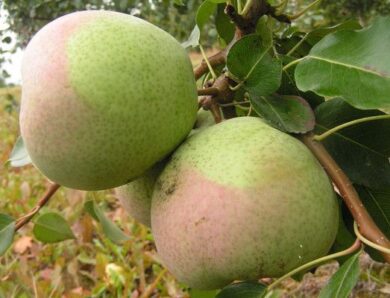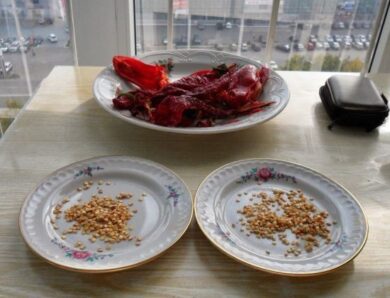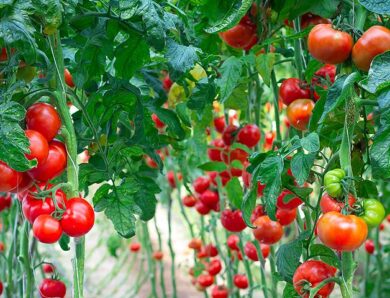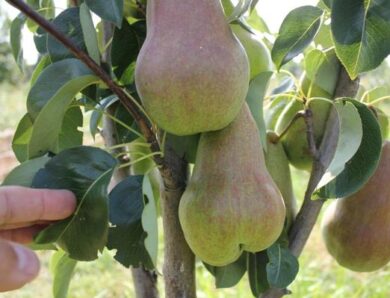Diseases of pear: causes and methods of treatment
Growing fruit trees on the site, the gardener always wants to get a rich harvest. Often a violation of the rules of agricultural technology causes diseases on your favorite pear. Many diseases are fungal in nature, spread by wind or insect vectors. From our material you will get comprehensive information about pear diseases and their control.
bacterial burns
Among the diseases, characteristic of pears, bacterial burns occur. It is manifested by dark brown or black spots on the leaf surface, branches and trunk. Infectious disease is caused by bacteria of the species Erwinia amylovora. Spread by insects, rain and wind. If you do not start treating the affected tree in time, the whole garden will perish.
After removing the diseased branches, the sections are treated with copper sulfate at the rate 100 g means on 10 And water. The use of Azophos solution will also help (5%), antibiotics streptomycin, gentamicin, kanamycin, chloramphenicol or nalidixic acid. For processing 10 trees will be needed 1-2 tablets, divorced in 5 l of liquid. During the flowering period, gardeners are treated with Bordeaux liquid. These methods of struggle are used, detecting the disease at an early stage. In case of severe damage to crops, they are uprooted and burned.
brown spot
Among other diseases of your pear may be brown spot. In late spring - early summer, the leaves appear unpleasant brown spots. They spread quickly, due to which the sheet curls and falls off. The peak of the disease occurs in July-August. There is also a white spot (or septoria), in which the leaves show rounded spots of dead tissue of light gray color with a dark rim. For the treatment of the fungus fallen leaves are removed, and trees are treated with copper-containing fungicides. Spraying is carried out after the beginning of fruit growth.
scab
Often the pear is affected by scabies. The causative agent of this disease is a fungus called Fusicladium pirinum. Symptoms: appearance on the fruit, as well as shoots and leaves of olive spots. As the disease progresses, cracks appear on the tree, and the fruit is deformed. It is recommended to remove the affected young shoots. If, if the disease is diagnosed at an early stage, triple treatment with copper chloride or Bordeaux liquid will help. For the first time it is carried out at the stage of bud appearance, further after flowering and through 2 weeks after the second treatment.
moniliosis
Continuing the conversation about pear diseases and methods of their treatment, it is impossible not to mention Moniliosis. Because rotten pears appear on crops, the disease is also called fruit rot. The disease is caused by the fungus Monilia fructigena. Later white growths are visible on fruits, and the flesh becomes loose and tasteless. The fruit in the process of decay falls off or stays dry for many months. The peak of the disease occurs in mid-July - August.
Hot and humid summer weather contributes to the spread. Affected branches and fruits, rotting, subject to destruction. If the disease is detected ??in time, carry out spraying of trees with fungicides.
mosaic disease
Numerous diseases and pests of pears bring a lot of trouble to gardeners. Among them is mosaic disease. It can be recognized by pale green or light yellow spots. They are awkward and look like a mosaic. They often appear on the leaves during tree grafting. In order not to risk healthy pears and other gardens, affected plants are burned.
soot fungus
Among the diseases of leaves and shoots is a dangerous soot fungus. The disease got its name because of the black plaque, which looks like soot. For the treatment of wood sprayed with copper-soap solution. It is prepared independently, mixing in 10 And water 5 g of copper sulphate and 150 Mr. dear. If soot fungus has appeared on the pear, it is customary to use Bordeaux liquid or copper chloride. Cathedral pear is resistant to this disease, which can be planted on the site.
Powdery mildew
When a grayish-white plaque is found on the surface of leaves and buds, we can talk about the defeat of the tree with powdery mildew. This disease, which causes the fungus Erysiphales, young cultures are more often ill during the period of kidney formation. Eventually, the plaque becomes red, and the leaves are deformed. To help the culture use antibiotics - penicillin, streptomycin and terramycin in proportion 1: 1. Effective and treatment with a solution of liquid soap in quantity 10 g with the addition 50 g of calcined salt. You can use a solution of manganese (1%).
rust
In early summer, dark orange spots may appear on your favorite tree. They concentrate on leaves and fruits. The disease got its name because of the external similarity of the spots with rust. Later the leaves are covered with unpleasant growths. The cause of the disease is the fungus Gymnosporangium sabinae.
Not only leaves and fruits suffer, but also shoots. The trees become weak and eventually stop bearing fruit. In the process of treatment, the affected areas are removed from the culture. A good effect is given by spraying the garden with copper sulfate and urea. Solutions also help, made of horsetail, marigolds and ashes.
root cancer
Root cancer is caused by the bacterium Agrobacterium tumefaciens. At defeat on a root neck of saplings characteristic outgrowths are visible. Before planting, purchased seedlings should be carefully inspected. Because when they land, bacteria settle in the soil structure, where they are quiet for several years. The help of the tree is to remove the affected areas of the root system. It must be disinfected with a solution of copper sulfate.
black cancer
Black cancer in the early stages is manifested by cracked bark. Then the disease affects the skeletal branches, trunk and rolls over the fruit. Brown spots are clearly visible near the cracks. Sick places of bark and fruit should be removed. Cracks are treated with a mixture of clay and mullein, copper sulphate or special oils. In order to prevent fallen leaves are collected and burned outside the site.
cytosporosis
The causes of cytosporosis are sunburn received by the tree and the presence of cracks due to exposure to low temperatures. A brief description of this disease of pears is as follows: the presence of red-brown spots on the culture and subsequent drying. The causative agent of the infection is a fungus of the species Cytospora leucostoma. Seeing the characteristic bumps on the bark, you should start treatment with the same drugs, as in previous illness. January and Moskvichka varieties are endowed with stable immunity to Cytosporosis, which can be planted in your garden.
Video "Diseases of fruit trees"
In this video you will learn about diseases of fruit trees and methods of their treatment.




